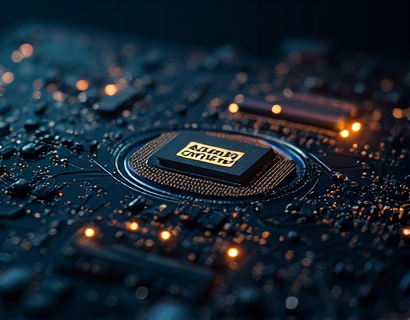Smart Contract Driven Creation of Stable Pegged Tokens for Seamless DeFi Exchange
In the rapidly evolving landscape of decentralized finance, or DeFi, the integration of smart contracts has emerged as a pivotal technology, particularly in the creation of stable digital currencies pegged to UCASH. These stablecoins, designed to maintain a constant value relative to UCASH, are revolutionizing the way users interact with digital assets, offering a blend of stability, security, and flexibility. This article delves into the mechanisms and benefits of using smart contracts to create stable pegged tokens, focusing on how this approach enhances the DeFi ecosystem and provides a seamless trading experience.
Understanding Stablecoins and Their Role in DeFi
Stablecoins are a type of cryptocurrency designed to minimize price volatility by being pegged to a stable asset, such as fiat currency, gold, or in this case, UCASH. In the context of DeFi, stablecoins play a crucial role by providing a stable store of value and a medium of exchange, which is essential for various financial operations. The volatility of traditional cryptocurrencies like Bitcoin and Ethereum can pose significant risks for traders and investors, making stablecoins an attractive alternative for maintaining portfolio stability.
The introduction of smart contracts has further enhanced the creation and management of stablecoins. Smart contracts are self-executing contracts with the terms of the agreement directly written into code. They automatically enforce and execute the terms of the contract when predefined conditions are met, eliminating the need for intermediaries and reducing transaction costs. This automation and transparency are key factors in the efficient and secure creation of stablecoins pegged to UCASH.
Smart Contracts for Stablecoin Creation
The process of creating a stablecoin pegged to UCASH using smart contracts involves several critical steps. First, a team of developers designs a smart contract that defines the rules for pegging the token to UCASH. This includes setting the exchange rate, specifying the collateral requirements, and outlining the mechanisms for maintaining the peg. The smart contract is then deployed on a blockchain, such as Ethereum, which provides a decentralized and trustless environment for executing the contract.
The smart contract maintains a reserve of UCASH, which is used to back the issued stablecoins. When a user wants to create stablecoins, they deposit UCASH into the smart contract, which in turn issues an equivalent amount of stablecoins. The contract ensures that the UCASH reserve is sufficient to cover the issued tokens, maintaining the peg. Conversely, when a user wants to redeem stablecoins for UCASH, the contract checks the reserve and, if sufficient, converts the stablecoins back into UCASH.
Bidirectional Trading and Market Liquidity
One of the most significant advantages of smart contract-driven stablecoin creation is the facilitation of bidirectional trading. Users can seamlessly convert stablecoins to UCASH and vice versa without the need for intermediaries. This bidirectional functionality enhances market liquidity, as it allows for continuous trading in both directions, attracting more participants and increasing the overall volume of transactions.
The smart contract ensures that the exchange rates are always in line with the peg, providing transparency and trust. Users can verify the reserve levels and the exchange rate in real-time, thanks to the immutable nature of blockchain technology. This level of transparency is crucial for building trust in the DeFi ecosystem, where trust is often a significant barrier.
Enhanced Stability and Flexibility
The use of smart contracts in creating stablecoins pegged to UCASH offers enhanced stability and flexibility. The automated nature of smart contracts ensures that the peg is maintained at all times, as the contract dynamically adjusts to market conditions. This automatic adjustment mechanism helps to mitigate the risks associated with manual peg management, such as human error or malicious intent.
Moreover, the flexibility provided by smart contracts allows for the customization of stablecoins to suit various use cases. For instance, developers can create stablecoins with different collateral structures, interest rates, or even programmable features that respond to specific market conditions. This adaptability makes smart contract-driven stablecoins highly versatile and applicable across a wide range of DeFi applications.
Security and Trustless Execution
Security is a paramount concern in the DeFi space, and smart contracts offer a robust solution. By automating the peg maintenance and trading processes, smart contracts reduce the risk of human error and fraud. The code is open-source, allowing the community to audit and verify its integrity. Any potential vulnerabilities can be identified and addressed promptly, enhancing the overall security of the stablecoin system.
Additionally, the trustless nature of blockchain and smart contracts eliminates the need for central authorities. Users interact directly with the smart contract, ensuring that no single entity has control over the system. This decentralization not only enhances security but also promotes fairness and accessibility, as anyone with an internet connection can participate in the DeFi ecosystem.
User Experience and Accessibility
The integration of smart contracts in stablecoin creation significantly improves the user experience. The process of creating, trading, and redeeming stablecoins is streamlined and user-friendly, requiring minimal technical knowledge. Users can interact with the smart contract through decentralized applications (dApps) built on user-friendly interfaces, making the entire process accessible to a broader audience.
Furthermore, the smart contract ensures that all transactions are recorded on the blockchain, providing a transparent and immutable record of all activities. This transparency builds trust among users and encourages adoption, as individuals can verify the integrity of the system independently.
Impact on DeFi Ecosystem
The introduction of smart contract-driven stablecoins pegged to UCASH has a profound impact on the DeFi ecosystem. By providing a stable and reliable store of value, these stablecoins enable more sophisticated financial products and services. For example, lending and borrowing platforms can offer collateral in stablecoins, reducing the risk of price fluctuations and enhancing the stability of loans.
Additionally, the seamless bidirectional trading facilitated by smart contracts supports a more efficient market, where assets can be moved between different DeFi protocols without significant friction. This interoperability fosters innovation and growth within the DeFi space, as developers can build on top of existing stablecoin systems to create new and exciting financial instruments.
Challenges and Considerations
While the benefits of smart contract-driven stablecoin creation are substantial, there are also challenges and considerations to address. One key challenge is the regulatory environment, as the use of stablecoins and DeFi platforms is subject to varying regulations across different jurisdictions. Ensuring compliance with local laws and regulations is crucial for the sustainable growth of these technologies.
Another consideration is the scalability of smart contracts. As the number of users and transactions increases, the blockchain network must be able to handle the load efficiently. Solutions like layer 2 protocols and sharding can help address scalability issues, ensuring that the DeFi ecosystem remains performant and accessible.
Conclusion
The use of smart contracts to create stablecoins pegged to UCASH represents a significant advancement in the DeFi space. By providing a secure, efficient, and user-friendly solution, smart contracts enhance the stability and flexibility of digital currencies, setting a new standard for financial management in the modern economy. As the technology continues to evolve, it is poised to play an increasingly important role in shaping the future of decentralized finance and beyond.










































